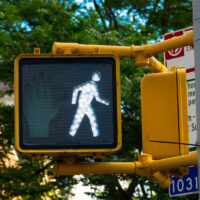What Evidence Is Needed in a Pedestrian Knockdown Case?

New York City is one of the busiest pedestrian hubs in the world, with millions of people walking its sidewalks and crossing its streets every day. Unfortunately, the high volume of foot traffic combined with congested roads means pedestrian knockdowns are all too common. When a pedestrian is struck by a vehicle, the injuries can be catastrophic, and securing fair compensation depends heavily on the strength of the evidence gathered after the accident.
Below, we break down the types of evidence that can be crucial in building a strong pedestrian knockdown case and why having an experienced NYC personal injury attorney on your side makes all the difference. If you or a loved one has been injured on the streets of Manhattan, Brooklyn, Queens, or the Bronx, contact Leandros A. Vrionedes, P.C., to speak with a skilled and experienced New York City pedestrian accident lawyer.
Police Reports and Accident Documentation
The police report is often the starting point in any pedestrian knockdown case. When officers respond to the scene, they typically record essential details such as:
- The location, date, and time of the accident
- Names and contact information of drivers, pedestrians, and witnesses
- Diagrams or narratives describing how the accident occurred
- Any traffic violations or citations issued
While not always conclusive, a police report creates an official record that can help establish liability. Attorneys will often use this report in conjunction with other forms of evidence to build the case.
Eyewitness Testimony
Independent witnesses can provide critical insights into how the accident happened. For example, a bystander may confirm that a driver ran a red light, failed to yield at a crosswalk, or was distracted by a cell phone. Witness accounts often carry weight because they are unbiased and can corroborate the pedestrian’s version of events.
If possible, pedestrians or their advocates should collect names and contact information from anyone who saw the accident. Witnesses can be harder to locate later, so securing statements early on is vital.
Video and Photographic Evidence
In a city as surveilled as New York, video evidence can play a decisive role in proving fault. Potential sources include:
- Traffic cameras at intersections
- Surveillance cameras from nearby businesses or apartment buildings
- Dashcam footage from the driver’s vehicle or other cars in the area
- Cellphone videos captured by witnesses
Photos of the accident scene, such as skid marks, vehicle damage, and crosswalk conditions, can also help reconstruct how the collision happened.
Medical Records and Expert Testimony
Medical documentation is a cornerstone of a pedestrian knockdown case. Emergency room records, diagnostic imaging, physician notes, and treatment plans establish both the nature and severity of injuries. These records also link the accident directly to the harm suffered.
In complex cases, expert medical testimony may be needed to explain the long-term effects of the injuries, potential disability, or the need for future care. This testimony helps quantify damages for settlement negotiations or trial.
Accident Reconstruction Evidence
In some pedestrian accidents, fault may not be immediately clear. Accident reconstruction experts use physics, engineering, and available data (such as skid marks, impact points, and video footage) to create models of how the crash occurred. Their findings can provide persuasive, science-based explanations of driver negligence.
Cell Phone and Electronic Records
Distracted driving is a leading cause of pedestrian accidents in NYC. Cell phone records showing that a driver was texting, making a call, or using social media at the time of the crash can be powerful evidence of negligence. Similarly, data from a vehicle’s “black box” or electronic data recorder (EDR) may reveal speed, braking, and other driving behaviors just before impact.
The Pedestrian’s Own Account
While statements must be carefully given to avoid speculation, the pedestrian’s own recollection of events is essential. An attorney will help present the pedestrian’s story clearly, highlighting details about traffic signals, crosswalk markings, and driver behavior. Importantly, injured pedestrians should avoid making offhand remarks such as “I didn’t see the car” or “I should have been more careful,” which insurers might use to shift blame.
Social Media and Post-Accident Conduct
Insurance companies and defense attorneys often scour social media accounts for information they can use against injury victims. Even innocent posts about daily activities can be misinterpreted as evidence that injuries are less severe than claimed. For this reason, it is best to avoid posting about the accident or recovery process until the case is resolved.
Why Strong Evidence Matters
In pedestrian knockdown cases, evidence serves two primary functions: proving liability and proving damages. The driver’s negligence must be established through objective proof, and the victim’s injuries must be documented in a way that demonstrates their impact on health, livelihood, and quality of life. Without strong evidence, insurance companies may undervalue claims or deny responsibility altogether.
Call Leandros A. Vrionedes, P.C. for Help
If you or a loved one has been injured in a pedestrian knockdown accident in New York City, gathering and preserving the right evidence is essential to protecting your rights. At Leandros A. Vrionedes, P.C., we know what it takes to build strong cases for injured pedestrians. We work quickly to secure police reports, witness statements, video footage, and medical documentation, while also consulting with experts when necessary to present the strongest case possible.
Don’t leave your recovery to chance or let insurance companies minimize your injuries. Contact us today for a free consultation and learn how we can help you pursue full compensation for your losses.


